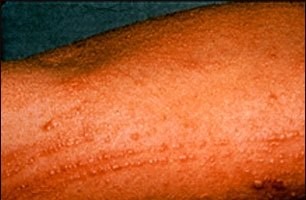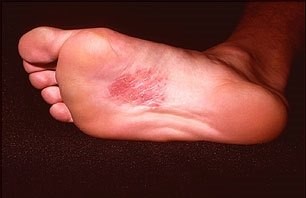Contact dermatitis
Contents
Contact dermatitis is a condition in which the skin becomes red, sore, or inflamed after direct contact with a substance. There are two kinds of contact dermatitis: irritant or allergic.
Poison oak rash on the arm. Several plants produce toxins that cause skin reaction. This is the appearance of poison oak dermatitis. Note the typical linear streaks produced either by scratching or brushing against the plant.
Causes
Irritant dermatitis is the most common type. It's caused by contact with acids, alkaline materials such as soaps and detergents, fabric softeners, solvents, or other chemicals. The reaction usually looks like a burn.
Other irritants may include:
- Cement
- Hair dyes
- Long-term exposure to wet diapers
- Pesticides or weed killers
- Rubber gloves
- Shampoos
Allergic contact dermatitis is caused by exposure to a substance or material to which you have become extra sensitive or allergic.
Common allergens include:
- Adhesives, including those used for false eyelashes or toupees
- Antibiotics such as neomycin rubbed on the surface of the skin
- Balsam of Peru (used in many personal products and cosmetics, as well as in many foods and drinks)
- Fabrics and clothing
- Fragrances in perfumes, cosmetics, soaps, and moisturizers
- Nail polish, hair dyes, and permanent wave solutions
- Nickel or other metals (found in jewelry, watch straps, metal zips, bra hooks, buttons, pocketknives, lipstick holders, and powder compacts)
- Poison ivy, poison oak, poison sumac, and other plants
- Rubber or latex gloves or shoes
Although you may not have a reaction to a substance when you are first exposed to it, regular use can eventually cause sensitivity and a reaction to the product.
Some products cause a reaction only when the skin is also exposed to sunlight (photosensitivity). These include shaving lotions, sunscreens, sulfa ointments, some perfumes, coal tar products, and oil from the skin of a lime. A few airborne allergens, such as ragweed or insecticide spray, can cause contact dermatitis.
The metal, nickel, can cause inflammation (erythema), rash, and itching. Nickel dermatitis is relatively common, and can be seen on the wrist from the stainless backs of watches, on the earlobes from nickel plated earrings, or elsewhere on the body from snaps. This person was in contact with something made of nickel or containing nickel salts.
Symptoms
Symptoms vary depending on the cause and whether the dermatitis is due to an allergic reaction or an irritant. The same person may also have different symptoms over time.
 Allergic reactions may occur suddenly, or only after months of being exposed to a substance.
Allergic reactions may occur suddenly, or only after months of being exposed to a substance.
The hands are a common site for contact dermatitis. Hair products, cosmetics, and perfumes often lead to skin reactions on the face, head, and neck. Jewelry can also cause skin problems in the area under it.
Itching of the skin in exposed areas is a common symptom. In the case of an allergic dermatitis, itching can be severe. Dermatitis caused by an irritant may also cause burning or pain.
Allergic dermatitis often causes a red, streaky, or patchy rash where the substance touched the skin. The allergic reaction is often delayed, with the rash appearing 24 - 48 hours after exposure. The rash may:
- Have red bumps that may form moist, weeping blisters
- Feel warm and tender
- Ooze, drain, or crust
- Become scaly, raw, or thickened
Irritant dermatitis often shows as dry, red, and rough skin. Cuts (fissures) may form on the hands. Skin may become inflamed with long-term exposure.

Exams and Tests
The diagnosis is mostly based on the skin appearance and a history of exposure to an irritant or an allergen.
Allergy testing with skin patches (called patch testing) may determine which allergen is causing the reaction. Patch testing is used for certain patients who have long-term, repeated contact dermatitis. It requires three office visits and must be done by a health care provider with the experience and skill to interpret the results correctly.
On the first visit, small patches of possible allergens are applied to the skin. These patches are removed 48 hours later to see if a reaction has occurred.
A third visit about 2 days later is done to look for any delayed reaction.
If you have already tested a material on a small area of your skin and noticed a reaction, you should bring the material with you.
Other tests may be used to rule out other possible causes, including skin lesion biopsy or culture of the skin lesion (see skin or mucosal biopsy culture).
Treatment
Treatment includes washing with lots of water to remove any traces of the irritant that may remain on the skin. You should avoid further exposure to known irritants or allergens.
In some cases, the best treatment is to do nothing to the area.
Emollients or moisturizers help keep the skin moist, and also help skin repair itself. They protect the skin from becoming inflamed again. They are a key part of preventing and treating contact dermatitis.
Corticosteroid skin creams or ointments may reduce inflammation. Carefully follow the instructions when using these creams. Overuse, even of low-strength over-the-counter products, may cause a skin condition.
Along with, or instead of corticosteroids, your health care provider may prescribe drugs called tacrolimus ointment or pimecrolimus cream to use on the skin.
In severe cases, corticosteroid pills may be needed. You will start them on a high dose, which is tapered gradually over about 12 days. You may also receive a corticosteroid shot.
Wet dressings and soothing anti-itch (antipruritic) or drying lotions may be recommended to reduce other symptoms.
Outlook (Prognosis)
Contact dermatitis usually clears up without complications in 2 or 3 weeks. However, it may return if the substance or material that caused it cannot be found or avoided.
Source: http://www.nlm.nih.gov/medlineplus/ency/article/000869.htm

